祈使句、感叹句和强调句
- 格式:doc
- 大小:15.00 KB
- 文档页数:2
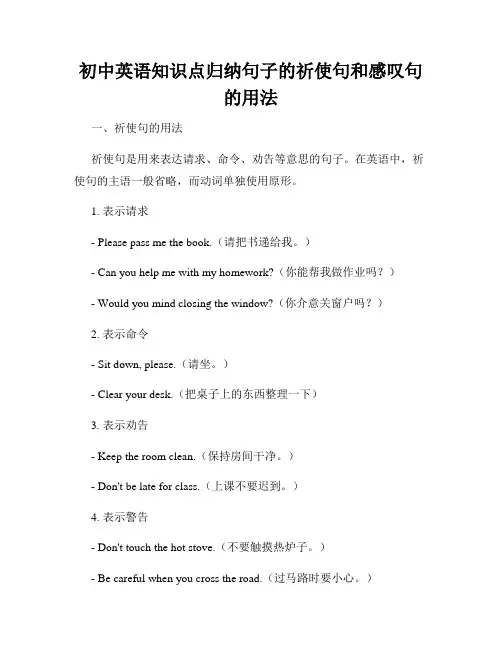
初中英语知识点归纳句子的祈使句和感叹句的用法一、祈使句的用法祈使句是用来表达请求、命令、劝告等意思的句子。
在英语中,祈使句的主语一般省略,而动词单独使用原形。
1. 表示请求- Please pass me the book.(请把书递给我。
)- Can you help me with my homework?(你能帮我做作业吗?)- Would you mind closing the window?(你介意关窗户吗?)2. 表示命令- Sit down, please.(请坐。
)- Clear your desk.(把桌子上的东西整理一下)3. 表示劝告- Keep the room clean.(保持房间干净。
)- Don't be late for class.(上课不要迟到。
)4. 表示警告- Don't touch the hot stove.(不要触摸热炉子。
)- Be careful when you cross the road.(过马路时要小心。
)二、感叹句的用法感叹句是用来表达惊喜、兴奋、疑问等强烈感情的句子。
在英语中,感叹句通常以"What"或"How"引导。
1. 表示惊奇或兴奋- What a beautiful flower!(多美的花啊!)- How amazing the fireworks are!(多么壮观的烟花啊!)2. 表示疑问- What time is it now?(现在几点了?)- How did you solve the math problem?(你是怎么解决这个数学题的?)3. 表示赞美- What a talented singer she is!(她真是个有才华的歌手!)- How wonderful the performance was!(演出太棒了!)4. 表示遗憾或抱怨- What a shame! I forgot to bring my wallet.(真糟糕!我忘记带钱包了。
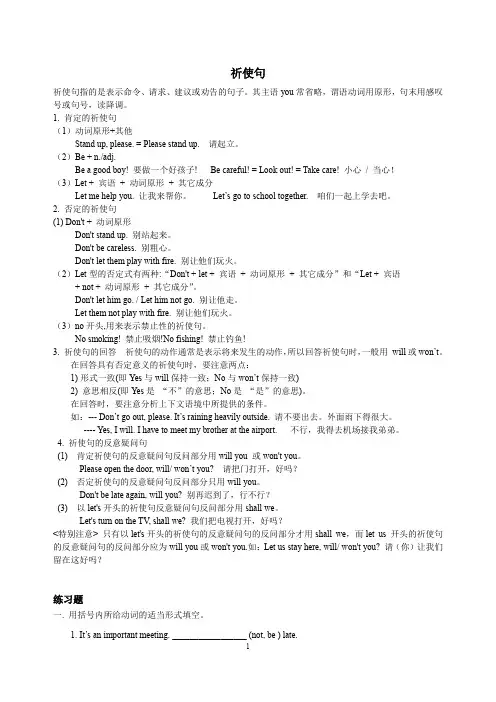
祈使句祈使句指的是表示命令、请求、建议或劝告的句子。
其主语you常省略,谓语动词用原形,句末用感叹号或句号,读降调。
1. 肯定的祈使句(1)动词原形+其他Stand up, please. = Please stand up. 请起立。
(2)Be + n./adj.Be a good boy! 要做一个好孩子! Be careful! = Look out! = Take care! 小心/ 当心!(3)Let + 宾语+ 动词原形+ 其它成分Let me help you. 让我来帮你。
Let’s go to school together. 咱们一起上学去吧。
2. 否定的祈使句(1) Don't + 动词原形Don't stand up. 别站起来。
Don't be careless. 别粗心。
Don't let them play with fire. 别让他们玩火。
(2)Let型的否定式有两种:“Don't + let + 宾语+ 动词原形+ 其它成分”和“Let + 宾语+ not + 动词原形+ 其它成分”。
Don't let him go. / Let him not go. 别让他走。
Let them not play with fire. 别让他们玩火。
(3)no开头,用来表示禁止性的祈使句。
No smoking! 禁止吸烟!No fishing! 禁止钓鱼!3. 祈使句的回答祈使句的动作通常是表示将来发生的动作,所以回答祈使句时,一般用will或won’t。
在回答具有否定意义的祈使句时,要注意两点:1)形式一致(即Yes与will保持一致;No与won’t保持一致)2) 意思相反(即Yes是“不”的意思;No是“是”的意思)。
在回答时,要注意分析上下文语境中所提供的条件。
如:--- Don’t go out, please. It’s raining heavily outside. 请不要出去。
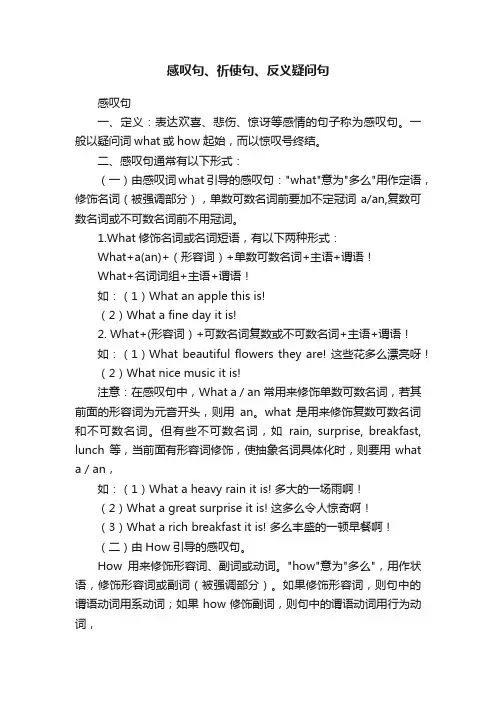
感叹句、祈使句、反义疑问句感叹句一、定义:表达欢喜、悲伤、惊讶等感情的句子称为感叹句。
一般以疑问词what或how起始,而以惊叹号终结。
二、感叹句通常有以下形式:(一)由感叹词what引导的感叹句:"what"意为"多么"用作定语,修饰名词(被强调部分),单数可数名词前要加不定冠词a/an,复数可数名词或不可数名词前不用冠词。
1.What修饰名词或名词短语,有以下两种形式:What+a(an)+(形容词)+单数可数名词+主语+谓语!What+名词词组+主语+谓语!如:(1)What an apple this is!(2)What a fine day it is!2. What+(形容词)+可数名词复数或不可数名词+主语+谓语!如:(1)What beautiful flowers they are! 这些花多么漂亮呀!(2)What nice music it is!注意:在感叹句中,What a / an 常用来修饰单数可数名词,若其前面的形容词为元音开头,则用an。
what 是用来修饰复数可数名词和不可数名词。
但有些不可数名词,如rain, surprise, breakfast, lunch 等,当前面有形容词修饰,使抽象名词具体化时,则要用what a / an,如:(1)What a heavy rain it is! 多大的一场雨啊!(2)What a great surprise it is! 这多么令人惊奇啊!(3)What a rich breakfast it is! 多么丰盛的一顿早餐啊!(二)由How引导的感叹句。
How用来修饰形容词、副词或动词。
"how"意为"多么",用作状语,修饰形容词或副词(被强调部分)。
如果修饰形容词,则句中的谓语动词用系动词;如果how修饰副词,则句中的谓语动词用行为动词,其结构是:How+形容词(副词)+主语+谓语!How+形容词+ a [an] +名词+S+V… !如:(1)How clever the girl is!(2)How quickly the boy is writing!(3)How kind a man he is! 他这个人真好!注意:当how修饰动词时,“how+主语+动词”构成,动词不跟着感叹词提到主语之前。
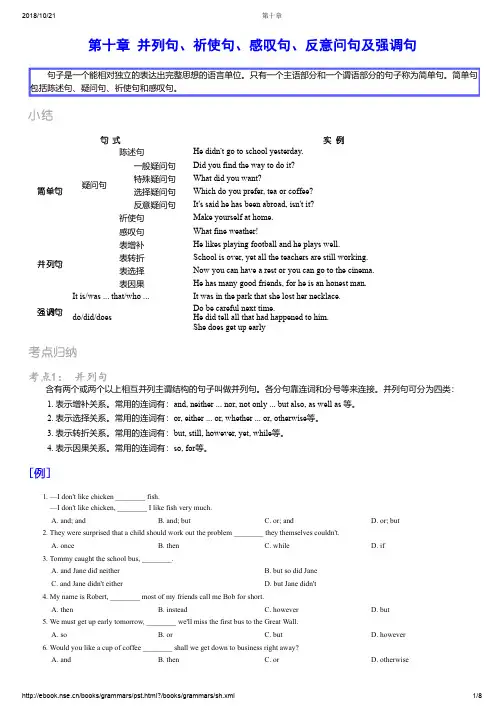
第十章并列句、祈使句、感叹句、反意问句及强调句句子是一个能相对独立的表达出完整思想的语言单位。
只有一个主语部分和一个谓语部分的句子称为简单句。
简单句包括陈述句、疑问句、祈使句和感叹句。
小结句式实例简单句陈述句He didn't go to school yesterday.疑问句一般疑问句Did you find the way to do it?特殊疑问句What did you want?选择疑问句Which do you prefer, tea or coffee?反意疑问句It's said he has been abroad, isn't it?祈使句Make yourself at home.感叹句What fine weather!并列句表增补He likes playing football and he plays well.表转折School is over, yet all the teachers are still working.表选择Now you can have a rest or you can go to the cinema.表因果He has many good friends, for he is an honest man.强调句It is/was ... that/who ...It was in the park that she lost her necklace. do/did/doesDo be careful next time.He did tell all that had happened to him.She does get up early考点归纳考点1:并列句含有两个或两个以上相互并列主谓结构的句子叫做并列句。
各分句靠连词和分号等来连接。
并列句可分为四类:1.表示增补关系。
常用的连词有:and, neither ... nor, not only ... but also, as well as 等。
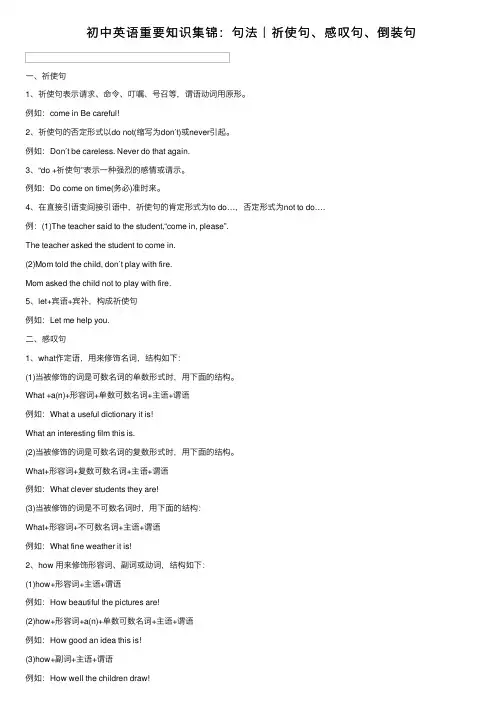
初中英语重要知识集锦:句法|祈使句、感叹句、倒装句⼀、祈使句1、祈使句表⽰请求、命令、叮嘱、号召等,谓语动词⽤原形。
例如:come in Be careful!2、祈使句的否定形式以do not(缩写为don′t)或never引起。
例如:Don′t be careless. Never do that again.3、“do +祈使句”表⽰⼀种强烈的感情或请⽰。
例如:Do come on time(务必)准时来。
4、在直接引语变间接引语中,祈使句的肯定形式为to do…,否定形式为not to do….例:(1)The teacher said to the student,“come in, please”.The teacher asked the student to come in.(2)Mom told the child, don′t play with fire.Mom asked the child not to play with fire.5、let+宾语+宾补,构成祈使句例如:Let me help you.⼆、感叹句1、what作定语,⽤来修饰名词,结构如下:(1)当被修饰的词是可数名词的单数形式时,⽤下⾯的结构。
What +a(n)+形容词+单数可数名词+主语+谓语例如:What a useful dictionary it is!What an interesting film this is.(2)当被修饰的词是可数名词的复数形式时,⽤下⾯的结构。
What+形容词+复数可数名词+主语+谓语例如:What clever students they are!(3)当被修饰的词是不可数名词时,⽤下⾯的结构:What+形容词+不可数名词+主语+谓语例如:What fine weather it is!2、how ⽤来修饰形容词、副词或动词,结构如下:(1)how+形容词+主语+谓语例如:How beautiful the pictures are!(2)how+形容词+a(n)+单数可数名词+主语+谓语例如:How good an idea this is!(3)how+副词+主语+谓语例如:How well the children draw!(4)how+主语+谓语例如:How time flies!3、感叹词的省略形式。

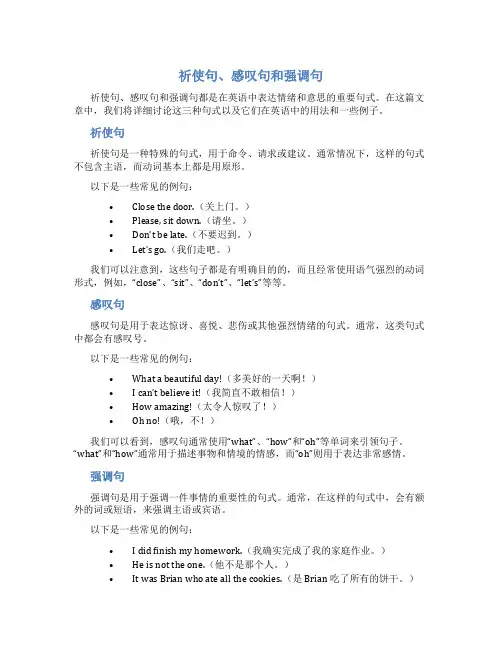
祈使句、感叹句和强调句祈使句、感叹句和强调句都是在英语中表达情绪和意思的重要句式。
在这篇文章中,我们将详细讨论这三种句式以及它们在英语中的用法和一些例子。
祈使句祈使句是一种特殊的句式,用于命令、请求或建议。
通常情况下,这样的句式不包含主语,而动词基本上都是用原形。
以下是一些常见的例句:•Close the door.(关上门。
)•Please, sit down.(请坐。
)•Don’t be late.(不要迟到。
)•Let’s go.(我们走吧。
)我们可以注意到,这些句子都是有明确目的的,而且经常使用语气强烈的动词形式,例如,“close”、“sit”、“don’t”、“let’s”等等。
感叹句感叹句是用于表达惊讶、喜悦、悲伤或其他强烈情绪的句式。
通常,这类句式中都会有感叹号。
以下是一些常见的例句:•What a beautiful day!(多美好的一天啊!)•I can’t believe it!(我简直不敢相信!)•How amazing!(太令人惊叹了!)•Oh no!(哦,不!)我们可以看到,感叹句通常使用“what”、“how”和“oh”等单词来引领句子。
“what”和“how”通常用于描述事物和情境的情感,而“oh”则用于表达非常感情。
强调句强调句是用于强调一件事情的重要性的句式。
通常,在这样的句式中,会有额外的词或短语,来强调主语或宾语。
以下是一些常见的例句:•I did finish my homework.(我确实完成了我的家庭作业。
)•He is not the one.(他不是那个人。
)•It was Brian who ate all the cookies.(是 Brian 吃了所有的饼干。
)•You, Emma, are my best friend.(你,Emma,是我最好的朋友。
)在所有这些情况下,额外的词和短语用来强调主语或宾语。
通常用来强调主语的方法是在句子的开头来放置。
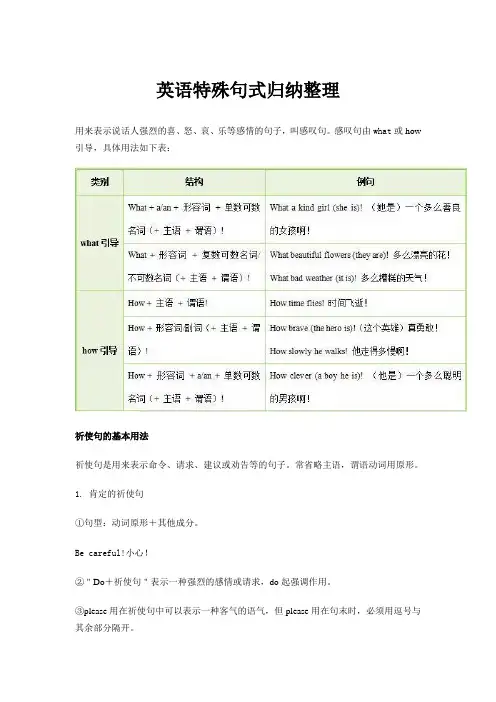
英语特殊句式归纳整理用来表示说话人强烈的喜、怒、哀、乐等感情的句子,叫感叹句。
感叹句由what或how 引导,具体用法如下表:祈使句的基本用法祈使句是用来表示命令、请求、建议或劝告等的句子。
常省略主语,谓语动词用原形。
1. 肯定的祈使句①句型:动词原形+其他成分。
Be careful!小心!②"Do+祈使句"表示一种强烈的感情或请求,do起强调作用。
③please用在祈使句中可以表示一种客气的语气,但please用在句末时,必须用逗号与其余部分隔开。
Close the door, please. 请关门。
2. 否定的祈使句①常用句型:Don’t+动词原形+其他成分。
Don’t be late for school again! 别再迟到了!②用Never开头:Never+动词原形+其他成分。
Never leave today’s work for tomorrow! 不要把今天的工作留到明天!3. Let引导的祈使句以Let开头的句子也是祈使句,表示陈述和建议。
其否定形式有两种:Let...not或Don’t...Let us not be late. 让我们不要迟到。
Don’t let the boy play football in the street. 不要让这个男孩在街上踢足球。
祈使句与简单句、复合句之间的转换1. "Let’s + 动词原形+ 其他"可转换为"Shall we + 动词原形+ 其他? "。
Let’s go fishing this afternoon. =Shall we go fishing this afternoon?2. "祈使句+ and/or + 简单句"可转换为含if引导的条件状语从句的复合句。
Use your head, and you’ll find a way. =If you use your head, you’ll find a way. Hurry up, or we’ll be late. =If we don’t hurry up, we’ll be late.祈使句的应答语1. 以Let’s开头的祈使句,其答语常用Good idea. /OK. /Yes, I’d love to.等。

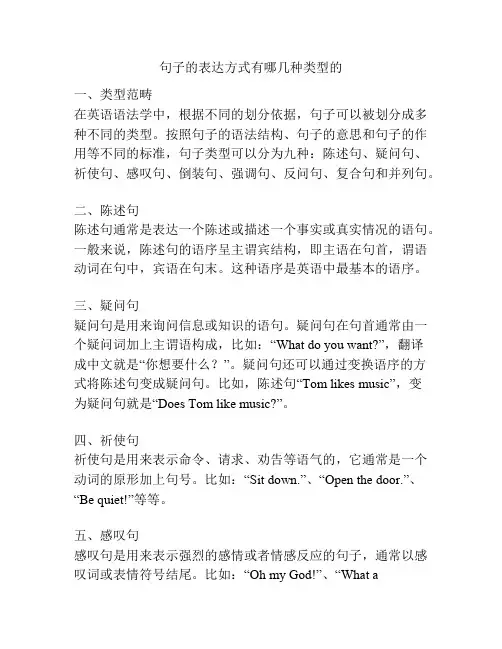
句子的表达方式有哪几种类型的一、类型范畴在英语语法学中,根据不同的划分依据,句子可以被划分成多种不同的类型。
按照句子的语法结构、句子的意思和句子的作用等不同的标准,句子类型可以分为九种:陈述句、疑问句、祈使句、感叹句、倒装句、强调句、反问句、复合句和并列句。
二、陈述句陈述句通常是表达一个陈述或描述一个事实或真实情况的语句。
一般来说,陈述句的语序呈主谓宾结构,即主语在句首,谓语动词在句中,宾语在句末。
这种语序是英语中最基本的语序。
三、疑问句疑问句是用来询问信息或知识的语句。
疑问句在句首通常由一个疑问词加上主谓语构成,比如:“What do you want?”,翻译成中文就是“你想要什么?”。
疑问句还可以通过变换语序的方式将陈述句变成疑问句。
比如,陈述句“Tom likes music”,变为疑问句就是“Does Tom like music?”。
四、祈使句祈使句是用来表示命令、请求、劝告等语气的,它通常是一个动词的原形加上句号。
比如:“Sit down.”、“Open the door.”、“Be quiet!”等等。
五、感叹句感叹句是用来表示强烈的感情或者情感反应的句子,通常以感叹词或表情符号结尾。
比如:“Oh my God!”、“What abeautiful day!”等等。
六、倒装句倒装句是在句子结构中将主语和谓语的位置交换的句子。
倒装句分两种情况:完全倒装句和部分倒装句。
完全倒装句是指将谓语动词移至主语之前,主语的位置要在动词之后,比如:Out came the sun. 部分倒装句是指将助动词或情态动词移到了主语的前面,比如:Never have I seen such a beautiful sight.七、强调句强调句是把某一成分放在句首或句尾,通过这种方式强调一些重要的信息。
比如:“It was Alfred who wrote the article.”,翻译成中文就是“是阿尔弗雷德写的这篇文章。
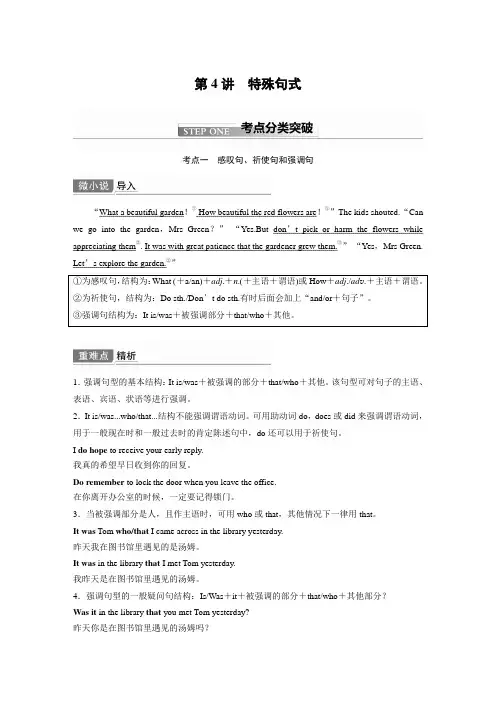
第4讲特殊句式考点一感叹句、祈使句和强调句“What a beautiful garden!① How beautiful the red flowers are!①”The kids shouted.“Can we go into the garden,Mrs Green?”“Yes.But don’t pick or harm the flowers while appreciating them②. It was with great patience that the gardener grew them.③”“Yes,Mrs Green. Let’s explore the garden.②”①为感叹句,结构为:What (+a/an)+adj.+n.(+主语+谓语)或How+adj./ad v.+主语+谓语。
②为祈使句,结构为:Do sth./Don’t do sth.有时后面会加上“and/or+句子”。
③强调句结构为:It is/was+被强调部分+that/who+其他。
1.强调句型的基本结构:It is/was+被强调的部分+that/who+其他。
该句型可对句子的主语、表语、宾语、状语等进行强调。
2.It is/was...who/that...结构不能强调谓语动词。
可用助动词do,does或did来强调谓语动词,用于一般现在时和一般过去时的肯定陈述句中,do还可以用于祈使句。
I do hope to receive your early reply.我真的希望早日收到你的回复。
Do remember to lock the door when you leave the office.在你离开办公室的时候,一定要记得锁门。
3.当被强调部分是人,且作主语时,可用who或that,其他情况下一律用that。
It was Tom who/that I came across in the library yesterday.昨天我在图书馆里遇见的是汤姆。
小学英语感叹句、祈使句语法知识汇总一、感叹句:1) What +名词+主语+谓语What a beautiful girl she is!What tall buildings they are!2) How +形容词+主语+谓语How beautiful the girl is!How tall the buildings are!在口语中,感叹句的主语和谓语常常省略:What a nice present!(省略it is)How disappointed!(省略she is或其它可作本句主、谓的词语)二、祈使句:肯定句:动词原型Come here, please.Go downstairs, please.Stand up.Sit down.Be quiet.Be careful.祈使句中如果有唤语,一定要用逗号隔开,放在句首或者句尾:Come in, Amy.Sit down here, Tom.Mary, give me a book please.否定:Don't+动词原型Don't come here.Don't sit down.Don't stand up.Don't give me it.let sb. do 让某人做Let me pass.Let us have a rest.Let's have a rest.反意疑问:Let's have a walk along the river, shall we?Let us go out for a drink, will you?。
考点分布备考指南强调句型 在理解的基础上,掌握各个特殊句式的句式特点,并能在做题的时候准确判定和灵活应用。
同时要注意这些特殊句式与其他语法知识的联系,比如祈使句和非谓语动词;强调句和it 固定句式等。
祈使句、感叹句 状语从句的省略词性转化与固定搭配 句子结构分析与文章理解理解并分析文章中出现的语法结构。
专题解读知识图谱特殊句式专题十六train火车;训练arrange安排vary 使多样化organize组织apply申请;应用transport交通tear眼泪;撕碎though虽然real真的present到场的,出席的;呈现absent不在场的,缺席的safe安全的fortunate幸运的involve牵扯,使卷入ill病的prevent阻止,防止medicine药relax放松design设计succeed成功person人suggest建议starve饿peace和平,安宁sudden突然的direct导演,指导;直接的wound受伤;伤口improve提高,改善expert专家require要求,需要知识清单必备词汇语法详解之强调句一、强调句型1.强调句型基本用法强调句常用来突出说话人要强调的语言信息,给对方以强烈的印象和感受。
译成汉语时,常加上“正是…”等字眼。
其基本结构是:It+ be的适当形式+被强调成分+that (who)+其他成分He bought the book in this shop yesterday.→It was he that bought the book in this shop yesterday. (强调主语he)→It was the book that he bought in this shop yesterday. (强调宾语the book)→It was in this shop that he bought the book yesterday. (强调地点状语in this shop)2.使用强调句型应注意的问题1)主谓一致It is your father who is wrong this timeIt is his parents who have come to China.主语谓语:保持一致2)人称一致It is I who am wrong.3)强调句的疑问形式一般问句:Is/Was it + 被强调部分+ that + ----Is it the dictionary that you are looking for?Was it yesterday that he was fired?特殊问句:疑问词+is/was +it +that+-----What is it that you want me to do ?Who was it that told you the news?When was it that you called me?How was it that you succeed?3.not … until … 句型的强调句句型为:It is/ was not until + 被强调部分+ that + 其它部分普通句:He didn’t go to bed until/ till his wife came back.强调句:It was not until his wife came back that he went to bed.总结归纳:当强调not…until结构时,必须将not until连用,后面接肯定式。
初中英语功能句初中阶段是英语学习的重要阶段,学习英语不仅需要学习语法和词汇,还需要掌握各种功能句型,这些句型可以帮助我们更好地表达自己,更好地理解他人。
下面介绍几种常见的初中英语功能句。
1.祈使句祈使句是一种常用的功能句型,用于表达请求、建议、命令等。
祈使句的主语是you,动词原形在句首。
例如:Clean your room.(打扫你的房间。
)、Listen to me.(听我说。
)、Be careful.(小心。
)等。
2.感叹句感叹句用于表达惊讶、高兴、痛苦等情感,语气强烈。
感叹句的结构为“What/How + 形容词/副词 + 主语 + 谓语”或“What/How + 名词 + 主语 + 谓语”。
例如:How beautiful the scenery is!(景色多么美丽啊!)、What a lovely dog!(多可爱的狗啊!)、How fast he runs!(他跑得多快啊!)等。
3.倒装句倒装句是一种特殊的语法结构,通过将谓语动词或助动词放在主语之前来构成。
倒装句常用于表达强调、感叹、疑问等语气。
例如:Never have I seen such a beautiful sunset.(我从未见过如此美丽的日落。
)、Only by working hard can you achieve your goals.(只有努力工作才能实现你的目标。
)、Not only did he study hard, but he also joined the school club.(他不仅努力学习,还参加了学校俱乐部。
)等。
4.虚拟语气虚拟语气用于表达假设、愿望、建议等情况,不是真实存在的语气。
虚拟语气的情况有很多种,例如虚拟条件句、虚拟语气的宾语从句、虚拟语气的主语从句等。
例如:If I were you, I would study harder.(如果我是你,我会更加努力学习。
)、I wish I could speak fluent English.(我希望我能说一口流利的英语。
1、祈使句结构
祈使句用以表达命令,要求,请求,劝告等。
1)祈使句有两种类型,一种是以动词原形开头,在动词原形之前加do (但只限于省略第二人称主语的句子)。
例如:
Take this seat. 坐这儿。
Do be careful.务必小心。
否定结构:例如:
Don't move.不准动。
Don't be late.不要迟到。
2)第二种祈使句以let开头。
Let 的反意疑问句:
a. Let's 包括说话者。
例如:
Let's have another try, shall we / shan't we? = Shall we have another try? 我们再试一次,如何?
b. Let us 不包括说话者。
例如:
Letus have another try,will you / won't you?=Will you please let us have another try? 你让我们再试一次,好吗?
否定结构:例如:
Let's not talk of that matter.不要谈这件事。
Letus not talk of thatmatter. 你不要让我们谈这件事。
2、强调句结构
常用的强调句结构是it 引导的句子,结构为It is(was)+ 被强调部分+ that (who)+句子的其余部分。
此结构强调的成分限于主语,宾语和状语。
例如:
It is from the sun that weget light and heat.我们是从太阳那儿获取光和热。
Itwas not until I had read your letter that I understood thetrue state of affairs. 知道读了你的信,我才知道实际情形。
典型例题
1)It was last night ___ I see the comet.
A.the time B. when C. that D. which
答案C. 强调句的结构是: It+be +强调部分+that (who))+ 主谓句。
强调句的连词只有两个,that和who。
当强调的部分是人,且为句子的主语时,才用 "who",其余用that。
强调句只有两张时态,一般现在时和一般过去时。
再如:原句:Myfatherdid the experiment in the lab yesterday evening.
强调主语: It wasmy father who did the experiment in the lab yesterday evening.
强调宾语:It was the experimentthat my father did in the lab yesterdayevening.
强调时间:It was yesterday evening that my father did theexperimentin the lab. (注意不用when)
强调地点: It was in the labthat my father did the experiment yesterday evenin g.
2)It isten years___ Miss Green returned to Canada.
A. that B.when C. since D. as
答案C. 考点是连词用法。
本题易误选为A. that. 其实本句不是强调句。
若是,去掉It be…tha t还应是一个完整的句子。
而本句去掉 'It is…that',只剩下ten years Miss Green return edto Canada. 不成句。
因此本句不是强调句。
3、感叹句结构
感叹句通常有what, how引导,表示赞美、惊叹、喜悦、等感情。
what修饰名词,how 修饰形容词,副词或动词,感叹句结构主要有以下几种:
掌握它的搭配,即掌握了感叹句的重点。
How +形容词+ a +名词+ 陈述语序。
例如:How clever a boy he is! 他是多聪明的孩子!
How+形容词或副词+陈述语序。
例如:Howlovely thebaby is! 小毛头真可爱!
What+名词+陈述语序。
例如:Whatnoise they are making! 他们真吵!
What+a+形容词+名词+陈述语序。
例如:What acleverboy he is! 他是多聪明的孩子!
What+ 形容词+复数名词+陈述语序。
例如:What wonderful ideas (we have)! 我们的主意真棒!
What+ 形容词+不可数名词+陈述语序。
例如:What cold weather it is! 多冷的天!。